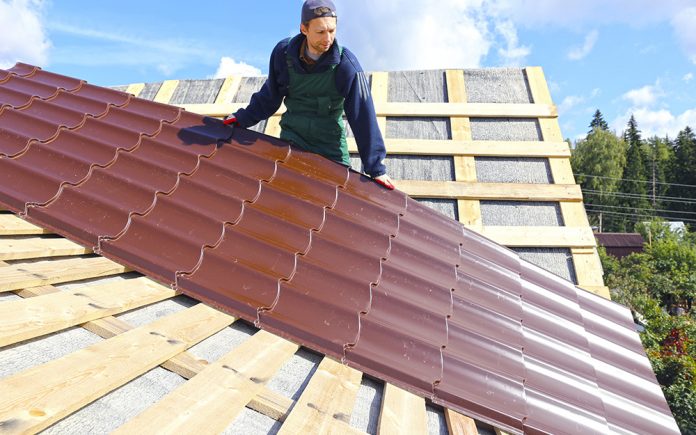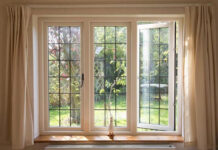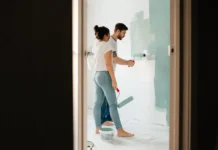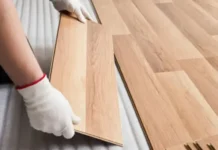Unless you are a professional, measuring your roof accurately and safely is bound to pose some challenges. The roof on most residential homes is not a perfect square and is characterized by pitch and angles that must be considered. Therefore, things tend to get a little complicated when measuring your home’s roof for metal roofing installation.
Nonetheless, with the right tips and tricks, anyone can measure their rooftop. Here is how to go about it safely and accurately with minimal wastage when roof installation begins.
The Basics
Draw a sketch of your roof top-down. This drawing does not have to be perfect as long as it clearly labels all measurements of the roof’s features in inches and feet. It will show the roof’s outline, valley lines, and ridge lines. The following measurements should be covered;
- Panel lengths
- Width measurements.
- The angle/pitch.
Do the same for adjacent structures such as the garage.
How to Determine the Roof’s Pitch
You calculate pitch by measuring the number of inches your roof rises vertically for every 12 inches that it extends horizontally. For instance, if you have a roof that rises 5 inches for every 12 inches of horizontal length, then the pitch is 5-in-12.
Here is how to safely do it from inside your attic;
- Have an 18 or 24-inch level, a pencil, and a tape measure.
- Mark 12 inches from one end of the level.
- Holding it perfectly leveled, place the level’s end against the bottom of the roof’s rafter in the attic
- Measure vertically from where the 12 inches mark is straight up to the rafter’s underside.
The measurement you get is your pitch.
In your sketch, you must include all other features attached to your roofs, e.g., overhangs and porches, that will need to be covered by the metal roofing.
Typically, you need 2 to 4 inches of overhang, but this figure may be less at times. However, some overhang is required to prevent water from going under the roof in conjunction with drip edge flashing.
Don’t Forget Chimneys and Skylights.
You need to take into account all protrusions from your roof. These usually include chimneys, piping, skylights, and other recessed areas. Add these features, if any, to your drawing and label them with measurements.
Metallic Panels
Work out the length of metal panels required by measuring the distance from the roof’s ridge to the fascia board. The fascia board is the board attached to your roofing joists.
If, for example, your roof measures 12 inches to the peak, this gives you the measurement of the total length of panels required.
Quick Tips and Tricks
Here are some quick tips and tips you can benefit from.
- Don’t measure to the edge of the shingles but instead focus on the dimensions of the roof’s deck. This way, you can consider the overhang and pull-back of the new panels.
- Order hip and valley panels that are a bit longer than their actual measurements. If installation conditions are slightly different, the extra dimensions will come in handy.
- Order an extra 10% of roofing materials to cater for erroneous calculations and damages during installation. The best way to go about this is to get a supplier that will give you a use or return deal. Such suppliers allow you to return the materials not used in construction.
- Seek advice from an experienced roofing expert on roofing overlap and the factors that influence overlap allowances
- Find out if there are jurisdictional guidelines and restrictions on matters of roofing.
Why Metallic Roofing?
Whether you want to replace the existing roof or are building a new house, metallic roofing is well worth considering.
Metallic roofing is becoming an increasingly popular alternative among homeowners. Here is why;
Longevity
Depending on the material, metal roofs can last between 40 and 70 years. Due to the high initial costs involved, this longevity is essential.
Durability
Metal roofs are not easily damaged by harsh elements like storms and strong winds.
Low maintenance
Due to the said durability, metal roofs do not require a rigorous maintenance regimen, thus saving you maintenance costs.
However, they require periodic inspection to identify problem areas that need repair.
Energy efficiency
An energy-efficient roofing material is essential because it cuts down your utility costs by reflecting solar heat away from your house. Metal roofing is energy efficient and reduces your utility costs by 10-25%.
Environment friendly
Metallic roofs are recycled at the end of their usable life. Therefore, very little of their metallic waste gets dumped into the environment. It is also possible that the metal roofing you are about to order has a certain percentage of recycled material.
Looking for a Roofing Expert?
AMT Metal Roofing is the affordable and excellent metal roofing partner that you have been looking for. We metal roofing installation for homes and businesses, and our clients enjoy a 50-year warranty.
Call us today or request a free quote to learn more about our metal roofing solutions.
Read Also : Pros vs. Cons: What Is the Best Type of Metal Roof for Your Home?



































































